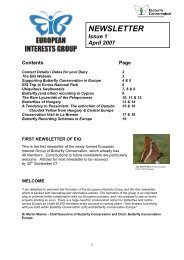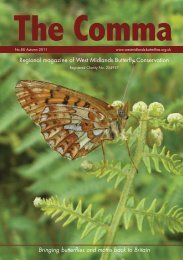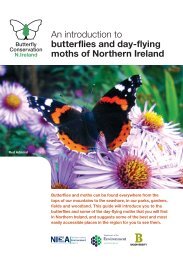Spring 2012 newsletter - Butterfly Conservation
Spring 2012 newsletter - Butterfly Conservation
Spring 2012 newsletter - Butterfly Conservation
Create successful ePaper yourself
Turn your PDF publications into a flip-book with our unique Google optimized e-Paper software.
Silver-washed Fritillary Photo Douglas Goddard<br />
Two species, Wood White and Dingy Skipper,<br />
had uncustomary (at least for Northants)<br />
second broods for the second successive<br />
year. The Wood White was seen in nine<br />
woods across its county range: Sywell,<br />
Hazelborough South Block, Salcey, Bucknell<br />
and five sections of Yardley Chase. The<br />
emergence comprised at least 38<br />
butterflies between 22 nd<br />
July and 19 th August.<br />
A single Dingy<br />
Skipper was found<br />
at Twywell on 5 th<br />
August, followed by six<br />
on both14 th and 15 th . This<br />
is the first multiple count of the<br />
second brood recorded in the county.<br />
Above left: Comma ab. suffusa Photo Matthew Oates<br />
Below: Purple Emperor ab. afflicta Photo Andy Wyldes<br />
9<br />
The number of sightings of Silver-washed<br />
Fritillary increased again in 2011, with sixteen<br />
locations recorded to date. This species seems<br />
to be well established again in the north of the<br />
county in Wakerley and Fineshade woods, in<br />
the Salcey and Yardley Chase area and in the<br />
Silverstone woods. The Purple Emperor was<br />
seen from 23 rd June in Fermyn Wood, reached<br />
a peak by the end of the month and had largely<br />
disappeared by mid-July. Eggs and caterpillars<br />
were very difficult to find this year in Northants<br />
and elsewhere (Matthew Oates et al.) and we<br />
may be in for a poor iris season next year. A<br />
stunning aberrant afflicta was photographed in<br />
Fermyn between 29 th June and 1 st July. The White<br />
Admiral had a poor year in 2011 though one<br />
obliterae specimen was seen in Fermyn Wood.<br />
Peacocks, Small Tortoiseshells and Commas<br />
were also in short supply in late summer. Matthew<br />
Oates photographed an aberration suffusa of<br />
the Comma in Fermyn Wood on 1 st July and I<br />
found another, obscura, at Stanwick Lakes on 25 th<br />
September.<br />
It was not a good year for migrants. Despite<br />
its early appearance, Painted Lady sightings<br />
were few and scattered, and it was not seen by<br />
many observers. Only three confirmed records<br />
of Clouded Yellows have been received to date.<br />
There was an influx of Red Admirals in late<br />
July, allowing local breeding and an increase in<br />
numbers seen on ivy blossom and in gardens<br />
through a warm October into November. The last<br />
record of the year came on 27th December in a<br />
Duston garden.<br />
A second successive warm <strong>Spring</strong> benefited some<br />
of our rarer and most threatened species, but<br />
the prolonged drought and cool summer may<br />
well have an detrimental impact on survival of<br />
the early stages and a decline in <strong>2012</strong>. Some<br />
multi-brooded species were able to build up their<br />
populations, but our more common ones which<br />
rely on grass growth for their caterpillars have<br />
declined for the second successive year and need<br />
to recover next time around. Overall, numbers of<br />
butterflies were low this year and it will go down<br />
as a poor one in general terms.







